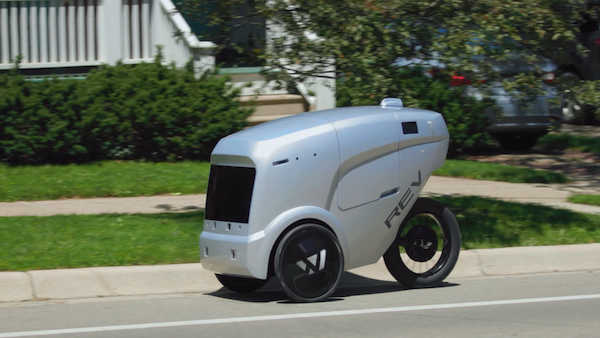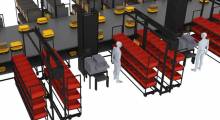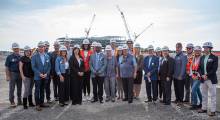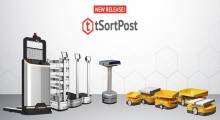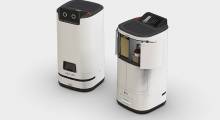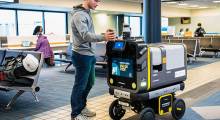Last-mile logistics can be a costly but important component of the extended supply chain. Goods must move from restaurants, fulfillment centers, retail stores, and other points of origin before traveling to customers or users. They most go through a complex series of transitions to successfully reach their final destinations. These items are not just parcels—they could be perishables such as groceries or food for dinner that evening.
Typically, last-mile delivery requires a fleet of vehicles as well as workers who must drive the vehicles and get out to bring orders right to the end users, wherever they may be. In a campus environment such as a hotel, a worker must make a separate trip from the kitchen, gift shop, or another location and go directly to the room of the party who had requested goods.
This entire dynamic is now changing, as the technologies for delivery robots mature. Such systems are making trips easier and more popular as they become further developed. The COVID-19 pandemic and parallel revolution in e-commerce have also driven interest in last-mile delivery robots.
Cleveron offers customizable vehicle
Cleveron is one of the world's leading robotics delivery companies. The Viljandi, Estonia-based company designed its Cleveron 701 robots specifically for retailers and logistics firms seeking to boost their last-mile efficiencies. The mobile robots can enable businesses to scale and meet expanding demand for same-day deliveries that are ordinarily performed by vehicles and employees.
The Cleveron 701 can be driven in low-traffic areas like suburbs and deliver orders to nearby customers within 15 to 30 minutes.
The goods come from a retailer or a fulfillment center. The delivery vehicle is supervised remotely, and its ability to efficiently deliver packages within an hour makes it very competitive with conventional methods.
In addition to saving time and consumer trips to the store, the Cleveron 701 also requires less labor. This reduces the cost because one teleoperator can supervise up to 10 robots at the same time.
Cleveron said its system is adaptable for different needs. For example, a temperature-controlled section can be added for grocery deliveries. The Cleveron 701 can also be used for parcel deliveries or even as a high-tech coffee robot or an ice cream truck.
Refraction AI
Delivery robots are increasingly being used for last-mile logistics across the U.S. The downtown neighborhoods of Austin, Texas, known as South Congress and Travis Heights are using robots produced by Refraction AI Inc. The Ann Arbor, Mich.-based company raised $4.2 million in April.
The REV-1 can deliver food orders from participating restaurants directly to the curbside of customers, said Refraction AI. After placing an order, the customer receives a text message with a unique code from the provider to be able to open the robot once it arrives.
In addition, texts also keep customers up to date on the whereabouts of the robot as the delivery progresses. When it does finally arrive at the destination, the customer is notified to meet the robot at the curb. The customer can input the code received as a text message and grab the order.
The REV-1 is no larger than a person on a bicycle, operating primarily on the side of the road or in a bike lane. It can travel in traffic lanes and sidewalks on a case-by-case basis. The robot has three wheels and is only about 4.5 ft. high and about the same distance long, but a mere 30 in. wide.
It weighs a total of 150 lb. and achieves speeds of up to 15 mph—fast enough to accomplish deliveries and stay on schedule with the minimum of stopping distance of any device on the road. The REV-1 has an internal capacity of 16 cubic feet or about six grocery bags worth of space. It's a voluminous vehicle that can serve a valuable utilitarian function.
Robotic room service
The concept of robotic deliveries is also being applied at the Bayside Hotel, a small boutique hotel in Santa Monica, Calif. The hotel has partnered with Los Angeles-based Coco, which raised $36 million in Series A funding last month, to provide deliveries on call during the day.
Guests can order a wide variety of things from a menu, as well as other kiosks and stores within the hotel. They might order food and beverages or sundries and personal care products. They even have a selection of items available for the pets of guests staying at the hotel.
Guests can place orders via a COCO app on their mobile devices. The robot operates from 9:00 a.m. to 10:00 p.m., seven days a week, and the hotel guests pay a $1.95 delivery fee.
These deliveries are an additional service the hotel is providing, but it is indicative of the potential of robots to perform similar services in any facility, adding a new level of convenience for patrons.
Not long ago, robotic delivery services seemed too complex to perform. As computer vision, autonomous or semi-autonomous navigation, and fleet management software develop, robots are providing new mobility services and changing transportation on roads or within facilities.
Now that robots have come of age and are starting to coexist with pedestrians, cyclists, and vehicles, it looks like last-mile logistics may have been solved with delivery robots.
About the Author
Follow Robotics 24/7 on Linkedin
Article topics
Email Sign Up

